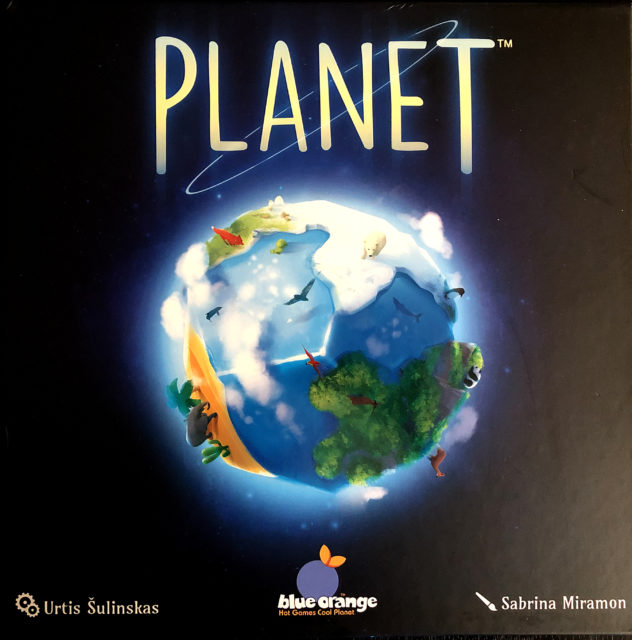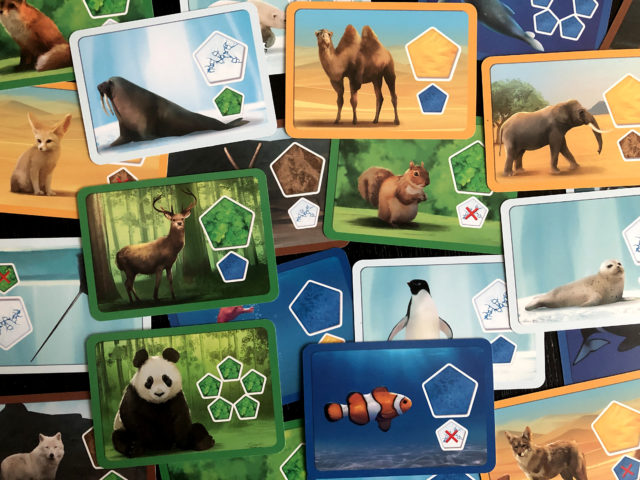Boardgames with components that you need to pick up and manipulate are pretty rare. There are plenty of games that ask you to stack or flick: Crokinole, Pitch Car, Rhino Hero. Some are more like toys, like Bop It! Then there are one-of-a-kinders like Mord Im Arosa, a mystery game whose nestable inserts stack into an apartment building and you throw clues (in the form of cubes of your colour) down the central stairwell to dislodge the murderer. (It’s a cool little filler; you should check it out.)
But what about a game that takes some of the tile-drafting and laying mechanics of Kingdomino and pushes them into a third dimension? That could be a thing, couldn’t it? Well, now it is a thing. A thing called Planet.
As you might recall, Planet made the biggest visual impression on me at Breakout last spring. It was hard to miss those big dodecahedrons (d12’s to you, RPGers) with pentagonal magnetic tiles. I just played around with those and I was sold, never mind the gameplay.

Fast forward a couple of months and it finally arrived at my FLGS. I am relieved to say that the game part of the game holds up very well. The designer, Urtis Šulinskas, has a slim c.v.–five games listed on BGG, one of them being a throwaway called Single Card Game. On the other hand, his last game Emojito, was nominated last year for the Kinderspiel des Jahres. So Planet didn’t just come out of nowhere.
The game has twelve rounds because your planet has twelve sides. Every round you draft a magnetic pentagonal tile and add it to your planet. Each tile is made up of five triangular areas, each of which can be any one of six possible terrain types: desert, jungle, mountain, arctic, ocean, or plains.
After drafting, there will usually be some species cards to divvy up. In the basic game they all start the game face-up so you can look ahead with perfect information; in the advanced game (recommended) half start face-down and you only get a three-turn look-ahead. Each species has a different and specific terrain requirement. Some require lots of non-adjacent regions of one type of terrain; others are looking for the largest area (in triangles) of a certain type adjacent–or not adjacent–to a certain other type. Whichever player best satisfies the criteria wins the card, which gets victory points at the end of the game. Ties are deferred until the next round (except for the final round, where there are tiebreakers).

At game’s end each player gets VPs for the species they have won, plus bonus points for satisfying a hidden condition they got before the start of the game. Most VP’s wins.
Planet is simple to teach, has excellent artwork on the species cards, and is challenging, even for spatial experts, because of the 3D element. It’s kid-friendly, language-independent, and also has enough interesting decisions to appeal to gamers. Since you use less than have the species cards every game there is a ton of replayability. And let’s face it: it’s the 3D element which really sells the game. Being able to hold a little baby pretend planet in your hand, turning it this way and that to figure out how to best place your tile, that’s an experience you can’t get with any other game. Strategy-wise it’s challenging because you’ll never be able to attract every single species; the trick is to plan ahead to see what’s coming up and arrange things as best as possible to nab as many as possible.
The release of Planet on Earth Day in North America was meant to embody publisher Blue Orange’s environmental activism. According to their website, Blue Orange Games has a policy of planting two trees for every tree used in making the wooden bits for their games, and has partnered with the PUR project to help offset its carbon footprint. My attitude to this is that every little bit helps, and since you can’t change the world you might as well do what you can. Your view may differ. Frankly, I didn’t know any of this until after I played and liked the game anyway, so it’s not as if it changed my opinion about it.
So get out there and make a planet already!
Thanks to 401 Games for providing a copy of Planet to review.
The link to “Mord im Arosa”actually leads to Rhino Hero page